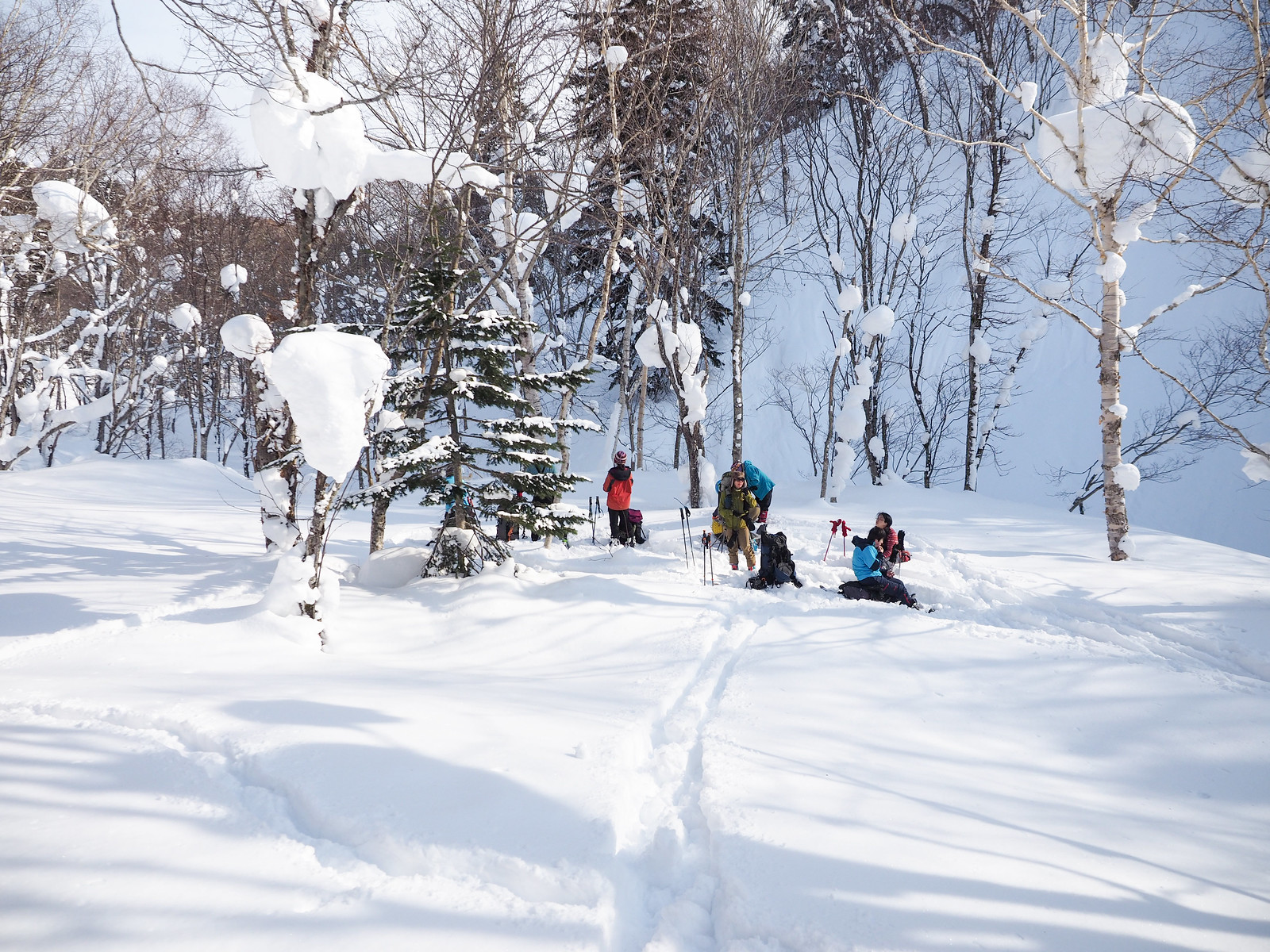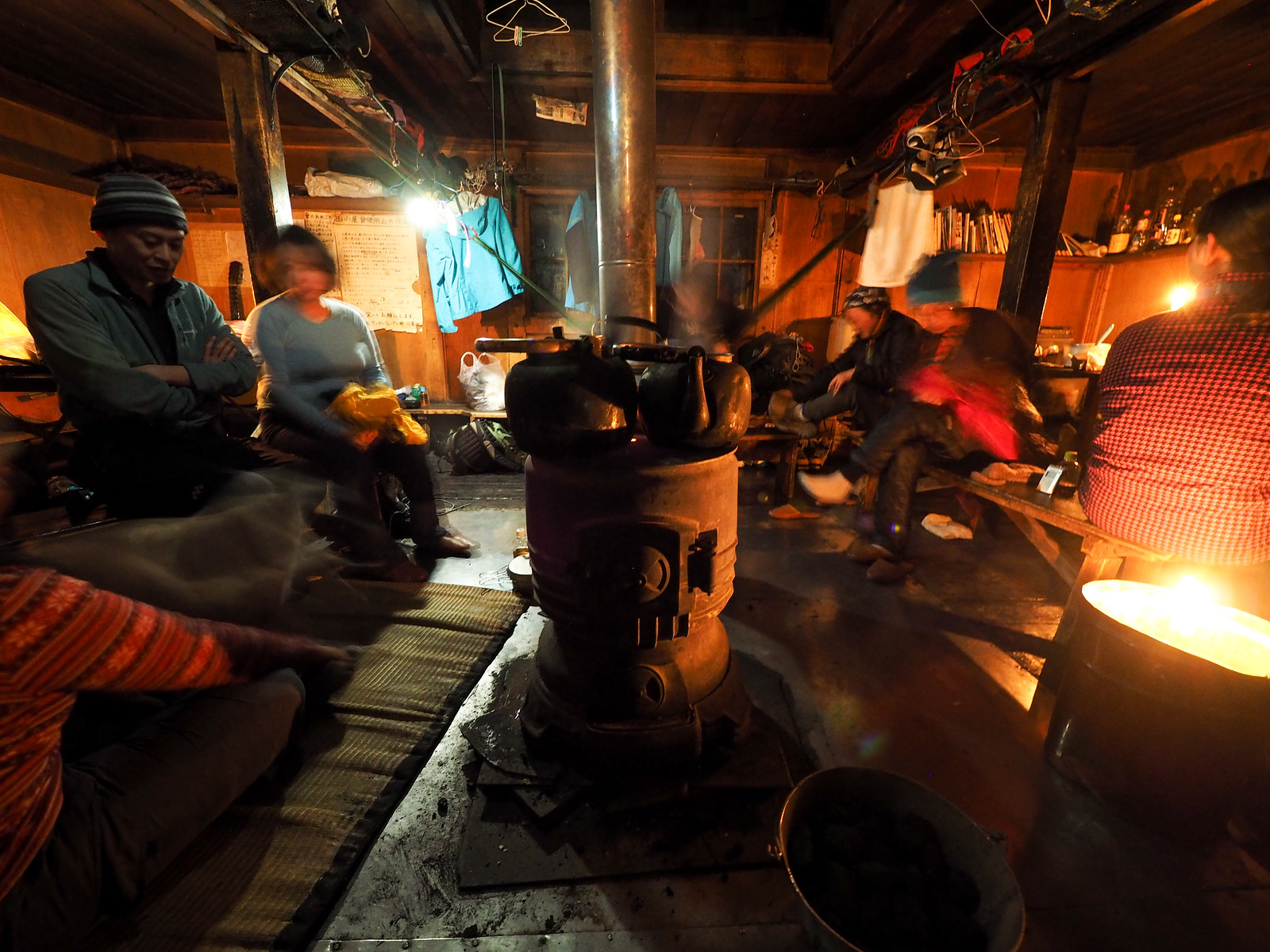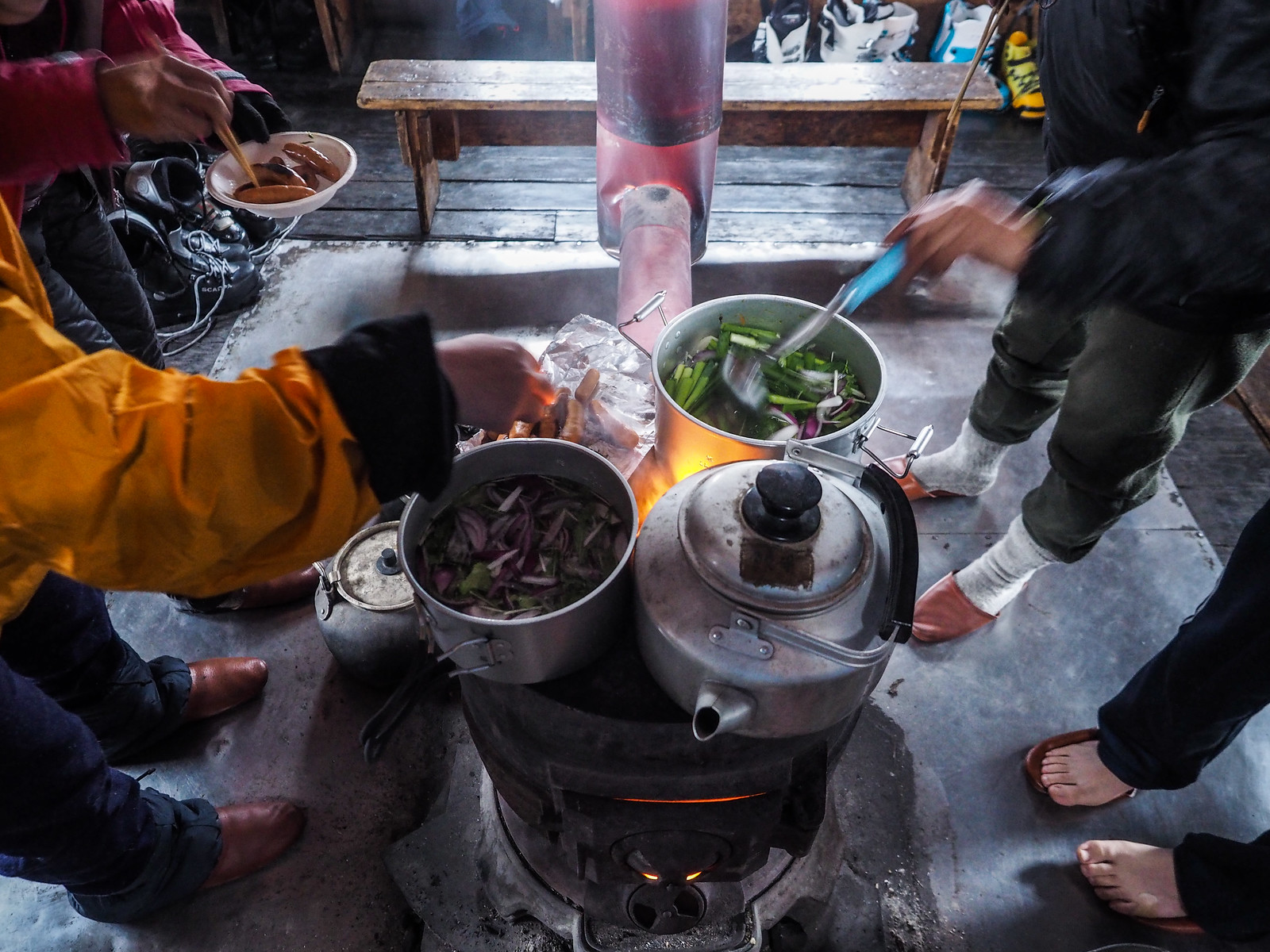We’d been meaning to go ski touring with Haidee’s colleague and friend Aiko for a few years now. In her undergraduate days at Hokkaido University, Aiko was a member of the Wandervogel Club, so she has climbed most of the major peaks in Hokkaido, as well as spent a great deal of time in one of the most iconic and historic backcountry huts in Hokkaido – Okuteine Yama-no-Ie (full hut details in this post).
At last a trip came together. Aiko invited us to join in on a trip organized by the Laligurash Womens’ Outdoor Club (https://laligura.exblog.jp/) to the Yama-no-Ie Hut. In addition to the normal female crew, Aiko’s son, a husband of one of the women, me, and Aiko’s Hokkaido-dog Jasper (named after Canada’s largest national park) were also invited.
All up there were a jolly bunch of 9 humans and one very energetic snow-loving dog, all on skis. Except the dog. Despite Jasper’s fondness for snow, he hasn’t learned to ski yet.
It was a relatively mild start to the trip, with about -5°C at the trailhead. After beacon checks and un-jamming Hayato’s Alpine-Trekkers, the group was moving at around 11:30am.
This would be my third time to visit the Yama-no-Ie hut. The first we approached via Mt. Okuteine (route guide), and the second time I was with Andy from Alaska for a three-day traverse, approaching the hut via Mt. Tsuge (route guide).
This time would be the first time I’ve approached the hut via the most direct route, along the Okuteine-sawa River. The route follows a forestry road until about half way to the hut.
Incidentally, the end of the forestry road is the point from which the Hokkaido University Wandervogel Club members haul the coal to the hut for the hut’s stove. “Each member hauls coal at least twice during their time as members of the club,” explained Aiko. “If you were hauling coal, your pack would weigh about 40kg. The challenge was to complete the hike to the hut – about 3km uphill – without putting your pack down!”
From the end of the forestry road, the route follows the valley floor most of the way to the hut. Even though the map shows a trail on the climber’s left of the river, this is not always the route taken in winter. There are frequent bluffs on both sides of the river, which require crossing the river on snowbridges every now and then.
The hut is at the foot of the head of the main catchment basin, an area marked on early 1900’s maps as “Paradise”. I could not think of a more apt name.
As we arrived at the hut, a light snowfall had begun. This continued overnight, such that the next day it was sometimes a challenge to see out skin tracks from the day before.
The first task at the hut was to get the coal stove cranking. This glorious iron stove, cast in Hakodate City, is extraordinarily powerful. It doesn’t take much to have the whole thing glowing red. Alas, however, a 100-year old hut does want for insulation, so beyond taking the bite out of the cold air in the hut, the hut will never be particularly warm, and any warmth lasts not much more than 10 minutes once the stove is off.
Bring a good sleeping bag!
The hut itself is much larger and well-appointed than most people expect. Like I mention in the Okuteine Yama-no-ie Hut details, the hut has a kitchen area (frigidly cold) with running water, toilets accessed from within the hut, and a full two stories of sleeping quarters.
The coal that the students lug up to the hut each year in autumn is stored under the hut, accessed via a trapdoor behind a door in the kitchen area.
Dinner that night was prepared by the ladies, and consisted of salad, rice, and Japanese hot-pot – always a treat in a cold hut after a day of skinning.
The next morning we woke to a typical Yama-no-ie morning: not a wisp of heat in the stove, and what felt well below freezing in the hut.
It took a while to get the stove going, but once it was stoked it at least warmed the vicinity of about 2m around the stove. It also facilitated the quick cooking of breakfast, once again organized and prepared by the ladies. This included sausages, toast, and hearty soup.
Yes, the flue in the second photo is glowing red hot.
There had been some talk the previous day of the group splitting into two for the morning. One group would head for the Mt. Okuteine peak, and the other would do a few laps of the Utopia Piste next to the hut. In the end, the whole group decided to ski the piste – untracked snow was waiting.
I led the trail-breaking, and was at the top in about 20 minutes, via a zig-zagging route through the trees to the climber’s left of the cleared piste. From a relatively flat spot above the piste, we transitioned to ski mode and devoured some very nice turns on excellent quality snow.
Hayato, a very capable skier in his own right, had found a snowboard in the hut that would attach to his ski boots. So he spent the better part of an hour post-holeing up the slope to give it a try.
Perhaps this one photo was worth it?
After a couple of hours doing a few laps, we all retired back to the hut for a break and to get ready to head back to the cars. Aiko led us with gusto in the hut-cleaning, wiping floors, hauling coal up from the basement, and clearing tables.
Of course we all signed the all-important visitor’s log also. It was great to see some entries from foreign visitors in there too.
From the hut, it was a dash back along our skin tracks back to the trailhead. Besides a few sections of side-stepping up some rises, it was possible to ski the entire way back to the cars on the skin track without resorting to putting skins back on the skis.
We finished the weekend with a soak in the Jozankei Hotel onsen (location), but only because the first recommendation of Hotel Milieu with its ample parking (location) was closed to day visitors on this particular occasion.
Many thanks to the Laligurash Womens’ Outdoor Club (https://laligura.exblog.jp/) for such a fun and relaxing weekend away in the hills!



















































1 thought on “Okuteine Hut and Utopia Piste via the Okuteine Valley Route”
My dog and I survived this golden week trek to the Oku teine yama no ie hut!! It was really challenging due to the high amount of snow melt making the river deep and fast, and there are indeed lots of river crossings. My dog begrudgingly hopped in the river with me, we had no choice! Also the weak snow bridges in the snow along the way posed a challenge. I’m not sure I’d do it again on foot at golden week. BC skiing in the winter seems to be the way to go. The hut is amazing, what a gem.